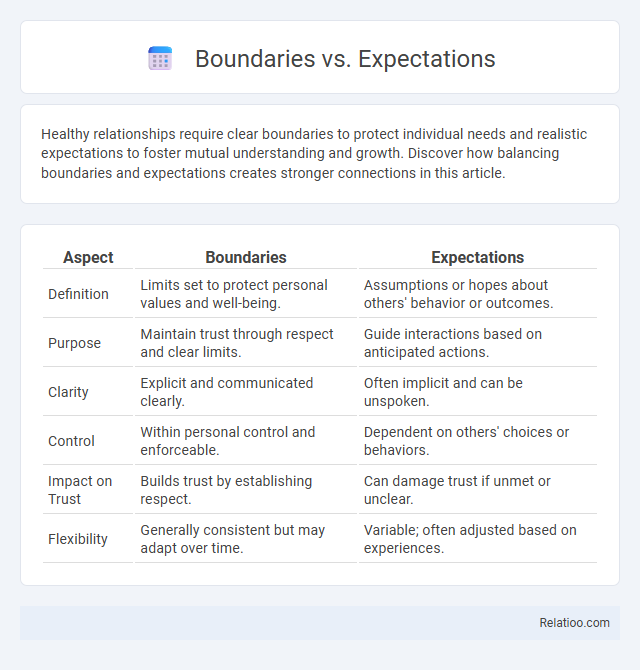Healthy relationships require clear boundaries to protect individual needs and realistic expectations to foster mutual understanding and growth. Discover how balancing boundaries and expectations creates stronger connections in this article.
Table of Comparison
| Aspect | Boundaries | Expectations |
|---|---|---|
| Definition | Limits set to protect personal values and well-being. | Assumptions or hopes about others' behavior or outcomes. |
| Purpose | Maintain trust through respect and clear limits. | Guide interactions based on anticipated actions. |
| Clarity | Explicit and communicated clearly. | Often implicit and can be unspoken. |
| Control | Within personal control and enforceable. | Dependent on others' choices or behaviors. |
| Impact on Trust | Builds trust by establishing respect. | Can damage trust if unmet or unclear. |
| Flexibility | Generally consistent but may adapt over time. | Variable; often adjusted based on experiences. |
Understanding Boundaries and Expectations
Understanding boundaries and expectations is essential to maintaining healthy relationships and personal well-being. Boundaries define the limits of acceptable behavior and protect your emotional space, while expectations are beliefs about how others should act or respond. Clear communication about both helps prevent misunderstandings and fosters mutual respect.
Key Differences Between Boundaries and Expectations
Boundaries define personal limits that protect one's well-being and establish what behaviors are acceptable, whereas expectations are beliefs or assumptions about how others should behave or respond. Boundaries are self-imposed rules critical for maintaining mental and emotional health, while expectations often stem from social, cultural, or relational norms and can lead to disappointment if unmet. Understanding the distinction between boundaries and expectations helps in setting clear limits and managing interpersonal relationships effectively.
The Importance of Setting Personal Boundaries
Setting personal boundaries is crucial for maintaining mental health, fostering self-respect, and cultivating healthy relationships. Clear boundaries prevent emotional exhaustion by defining acceptable behavior and protecting individual needs from being overlooked. Establishing boundaries also minimizes misunderstandings by aligning expectations with personal limits, ensuring mutual respect and effective communication.
How Expectations Shape Relationships
Expectations play a crucial role in shaping relationships by setting perceived norms for behavior and communication, influencing how partners interact and respond to each other's needs. Clear, realistic expectations help prevent misunderstandings and foster mutual respect, while unrealistic or unspoken expectations can lead to conflict and disappointment. Understanding the distinction between boundaries and expectations allows you to articulate your needs clearly, promoting healthier and more satisfying relationships.
Common Misconceptions About Boundaries
Common misconceptions about boundaries often confuse them with expectations or personal preferences, leading to misunderstandings in relationships. Boundaries are clear limits set to protect individual well-being, while expectations are assumptions about how others should behave, which may not be explicitly communicated. Recognizing these distinctions helps prevent resentment and promotes healthier interactions by ensuring boundaries are respected rather than mistaken for negotiable desires.
The Impact of Unspoken Expectations
Unspoken expectations often lead to misunderstandings and resentment because they create invisible boundaries that people assume rather than communicate. These ambiguous limits can blur the distinction between healthy boundaries and unmet expectations, causing emotional strain and confusion in relationships. Clearly articulating expectations prevents misinterpretation, preserves trust, and strengthens personal and professional interactions.
Healthy Communication Around Boundaries
Healthy communication around boundaries involves clearly expressing personal limits while respecting others' feelings and needs to foster mutual understanding and trust. Differentiating boundaries from expectations is essential; boundaries define non-negotiable personal limits, whereas expectations are anticipations about others' behavior that can be flexible and negotiated. Establishing these distinctions enhances emotional safety, reduces conflict, and strengthens relationships through open, honest dialogue.
Managing Conflict Between Boundaries and Expectations
Managing conflict between boundaries and expectations requires clear communication to prevent misunderstandings and resentment. Establishing firm personal boundaries ensures mutual respect, while setting realistic expectations promotes cooperation and trust. Balancing these elements enhances emotional well-being and supports healthy relationships.
Setting Realistic Expectations in Daily Life
Setting realistic expectations in daily life helps maintain healthy boundaries by clearly defining what you can and cannot accommodate without overextending yourself. Your ability to differentiate between expectations and boundaries ensures emotional well-being and prevents misunderstandings in personal and professional relationships. Understanding the balance between these concepts empowers you to communicate needs effectively while managing stress and fostering mutual respect.
Strategies for Balancing Boundaries and Expectations
Balancing boundaries and expectations requires clear communication and consistent enforcement to protect your well-being while fostering healthy relationships. Setting realistic expectations aligned with your personal limits helps prevent misunderstandings and emotional exhaustion. Regularly reassessing and adjusting boundaries ensures that both your needs and others' expectations are honored effectively.

Infographic: Boundaries vs Expectations
 relatioo.com
relatioo.com